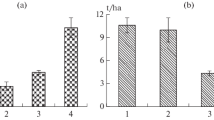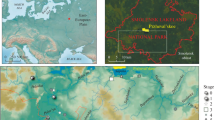Abstract
A comparative assessment of the carbon stock in loamy soils (Albic Retisols) of coniferous–broadleaved forests on the Moskvoretsko-Oksky Plain and sandy soils (Albic Podzols) in the Bryansk region is given. The carbon accumulation in soils is related to the texture of their mineral horizons and biotic factors, such as the quality of litter and activity of earthworms. The forests on sandy soils were characterized by a high carbon stock in the plant litter, which is explained by the low biomass of earthworms. The carbon content was significantly higher in the mineral horizons of loamy soils owing to high share of fine particles. The carbon stock in the litter and mineral horizons of loamy and sandy soils turned out to be comparable, except for the sandy soils of mixed forests due to higher clay content. In the course of succession of the coniferous-deciduous forests on the loamy soil, the carbon accumulation in the litter was high only at the late stage due to the high input of spruce needles. The carbon stock in the humus horizons of the loamy soils varied due to changes in their density, which was regulated by earthworms. When comparing different succession stages/types of the forests on sandy soils, it was found that the carbon stock in the litter of the pine forests at the early stage of succession was significantly higher than that of the mixed and broadleaved forests. Trends of carbon accumulation in the mineral horizons of sandy soils were mainly explained by their thickness, which was related to the amount of percolating precipitation regulated by woody plants.


Similar content being viewed by others
REFERENCES
T. S. Vsevolodova-Perel’, Earthworms in Russian Fauna: Cadaster and Guide for Identification (Nauka, Moscow, 1997) [in Russian].
E. G. Gavrilenko, Candidate’s Dissertation in Biology (Moscow, 2013).
E. G. Gavrilenko, E. A. Susyan, N. D. Anan’eva, and O. A. Makarov, “Spatial variability in the carbon of microbial biomass and microbial respiration in soils of the south of Moscow oblast,” Eurasian Soil Sci. 44, 1125–1138 (2011).
A. V. Gornov, M. V. Gornova, E. V. Tikhonova, N. E. Shevchenko, and A. I. Kazakova, “Evaluation of succession of coniferous-broad leaved forests of European part of Russia based on population approach,” Lesovedenie, No. 6, 16–30 (2018).
O. I. Evstigneev, Nerusso-Desnyanskoe Polesie: History of Nature Management (Bryansk, 2009) [in Russian].
L. B. Zaugol’nova and V. B. Martynenko, Guide for identification of forest types in European Russia, 2012. http://cepl.rssi.ru/bio/forest/index.htm. Accessed May 1, 2018.
A. I. Kazakova, A. A. Semikolennykh, A. V. Gornov, M. V. Gornova, and N. V. Lukina, “Influence of vegetation on the lability characteristics of sandur areas of the Bryansky Les Nature Reserve, Moscow Univ. Soil Sci. Bull. 73, 100–106 (2018).
L. O. Karpachevskii, Variegation of the Soil Cover in Forest Biogeocenosis (Moscow State University, Moscow, 1977) [in Russian].
L. L. Shishov, V. D. Tonkonogov, I. I. Lebedeva, and M. I. Gerasimova, Classification and Diagnostic System of Russian Soils (Oikumena, Smolensk, 2004) [in Russian].
Climate of Russia: Scientific-Applied handbook. http://meteo.ru/pogoda-iklimat/197-nauchno-prikladnoj-spravochnik-klimat-rossii. Accessed July 1, 2018.
Landscapes of Moscow Oblast and their Modern Status, Ed. by I. I. Mamai (Smolensk State Humanitarian University, Smolensk, 1997) [in Russian].
Order of the Ministry of Natural Resources and Ecology of Russian Federation no. 20-r of June 30, 2017 On recommendations for qualitative measurements of absorption volume of greenhouse gases. https://www. garant.ru/products/ipo/prime/doc/71612096/. Accessed July 1, 2018.
O. V. Smirnova, “Methods and evaluation of climax and succession states of forest ecosystems by the example of East European forests,” Lesovedenie, No. 3, 15–27 (2004).
K. K. Fasulati, Field Study of Terrestrial Invertebrates (Vysshaya Shkola, Moscow, 1971) [in Russian].
O. V. Chestnykh, V. A. Lyzhin, and A. V. Koksharova, “Carbon reserves in the forest litter of Russia,” Lesovedenie, No. 6, 114–121 (2007).
I. V. Shablii, Candidate’s Dissertation in Biology (Kyev, 1990).
N. E. Shevchenko, A. I. Kuznetsova, D. N. Tebenkova, V. E. Smirnov, A. P. Geraskina, A. V. Gornov, E. V. Tikhonova, and N. V. Lukina, “Succession dynamics of soil carbon pools and vegetation in coniferous–broadleaved forests of Northeastern Caucasus,” Lesovedenie, No. 3, 1–14 (2019).
I. M. Shpakievskaya, “Agrogenic transformation of morphological, physicochemical, and ecophysiological properties of soddy-weak podzolic soils of Volynskoe forest area (Ukraine),” in Proceedings of the International Scientific Conference, Minsk, September 14–17, 2016 (Belarusskaya Navuka, Minsk, 2016), Vol. 2, pp. 80–83.
D. G. Schepaschenko, L. V. Mukhortova, A. Z. Shvidenko, and E. F. Vedrova, “The pool of organic carbon in the soils of Russia,” Eurasian Soil Sci. 46, 107–116 (2013).
Š. Angst, C. W. Mueller, T. Cajthaml, G. Angst, Z. Lhotáková, M. Bartuška, A. Špaldoňová, and J. Frouz, “Stabilization of soil organic matter by earthworms is connected with physical protection rather than with chemical changes of organic matter,” Geoderma 289, 29–35 (2017).
K. E. Clemmensen, A. Bahr, O. Ovaskainen, A. Dahlberg, A. Ekblad, H. Wallander, and B. D. Lindahl, “Roots and associated fungi drive long-term carbon sequestration in boreal forest,” Science 339 (6127), 1615–1618 (2013).
M. Falk, T. H. Suchanek, S. L. Ustin, J. Chen, Y.‑S. Park, W. E. Winner, S. C. Thomas, T. C. Hsiao, R. H. Shaw, T. S. King, R. D. Pyles, M. Schroeder, and A. A. Matista, “Carbon dioxide exchange between an old-growth forest and the atmosphere,” Ecosystems 7 (5), 513–524 (2004).
E. Framstad, H. Wit, R. Mäkipää, M. Larjavaara, L. Vesterdal, and E. Karltun, Biodiversity, Carbon Storage and Dynamics of Old Northern Forests (Nordic Council of Ministers, Copenhagen, 2013).
K. Fujisaki, L. Chapuis-Lardy, A. Albrecht, T. Razafimbelo, J. L. Chotte, and T. Chevallier, “Data synthesis of carbon distribution in particle size fractions of tropical soils: implications for soil carbon storage potential in croplands,” Geoderma 313, 41–51 (2018).
F. Husson, S. Le, and J. Pagès, Exploratory Multivariate Analysis by Example Using R, 2nd ed. (CRC Press, Boca Raton, Fl, 2017).
L. Kenina, D. Elferts, E. Baders, and A. Jansons, “Carbon pools in a hemiboreal over-mature Norway spruce stands,” Forests 9 (7), 435 (2018).
Y. Kooch and H. Jalilvand, “Earthworms as ecosystem engineers and the most important detritivors in forest soils,” Pak. J. Biol. Sci. 11 (6), 819–825 (2008).
A. M. Kooijman, J. M. van Mourik, and M. L. M. Schilder, “The relationship between N mineralization or microbial biomass N with micromorphological properties in beech forest soils with different texture and pH,” Biol. Fertil. Soils 45 (5), 449 (2009).
S. L. Lewis, G. Lopez-Gonzalez, B. Sonké, K. Affum-Baffoe, T. R. Baker, L. O. Ojo, O. L. Phillips, J. M. Reitsma, L. White, J. A. Comiskey, K. M.‑N. Djuikouo, T. R. Feldpausch, A. C. Hamilton, M. Gloor, T. Hart, et al., “Increasing carbon storage in intact African tropical forests,” Nature 457 (7232), 1003 (2009).
S. Luyssaert, E. D. Schulze, A. Börner, A. Knohl, D. Hessenmöller, B. E. Law, P. Ciais, and J. Grace, “Old-growth forests as global carbon sinks,” Nature 455 (7210), 213 (2008).
C. A. McClaugherty and B. Berg, “Cellulose, lignin and nitrogen levels as rate-regulatory factors in late stages of forest litter decomposition,” Pedobiologia 30, 101–112 (1987).
R Core Team, R: A Language and Environment for Statistical Computing (R Foundation for Statistical Computing, Vienna, 2017). http://www.R-project.org.
D. A. Wardle, M. Jonsson, S. Bansal, R. D. Bardgett, M. J. Gundale, and D. B. Metcalfe, “Linking vegetation change, carbon sequestration and biodiversity: insights from island ecosystems in a long-term natural experiment,” J. Ecol. 100 (1), 16–30 (2012).
IUSS Working Group WRB, World Reference Base for Soil Resources 2014, International Soil Classification System for Naming Soils and Creating Legends for Soil Maps, World Soil Resources Reports No. 106 (Food and Agriculture Organization, Rome, 2015).
G. Zhou, S. Liu, Z. Li, D. Zhang, X. Tang, C. Zhou, J. Yan, and J. Mo, “Old-growth forests can accumulate carbon in soils,” Science 314 (5804), 1417–1417 (2006).
ACKNOWLEDGMENTS
The chemical analyses were performed in the ecoanalytical laboratory “Khromatographiya” (no. 3297) of the Institute of Biology, Komi Scientific Center, Ural Division, Russian Academy of Sciences (Certificate of Accreditation № ROSS RU.0001.511257).
Funding
Field studies and quantification of carbon and nitrogen were supported by the Russian Science Foundation (project no. 16-17-10284). The processing of the results was carried out within the framework of the state contract of the Center for Forest Ecology and Productivity of the Russian Academy of Sciences no. 0110-2018-0007 and the Program of the Presidium of the Russian Academy of Sciences no. 0110-2018-0005.
Author information
Authors and Affiliations
Corresponding author
Additional information
Translated by L. Kholopova
Rights and permissions
About this article
Cite this article
Kuznetsova, A.I., Lukina, N.V., Tikhonova, E.V. et al. Carbon Stock in Sandy and Loamy Soils of Coniferous–Broadleaved Forests at Different Succession Stages. Eurasian Soil Sc. 52, 756–768 (2019). https://doi.org/10.1134/S1064229319070081
Received:
Revised:
Accepted:
Published:
Issue Date:
DOI: https://doi.org/10.1134/S1064229319070081




